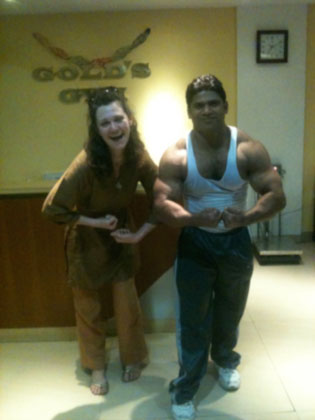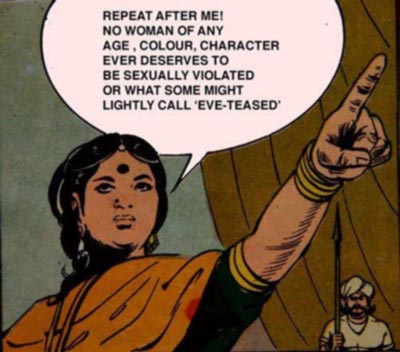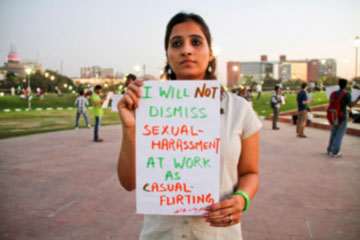Sex and the Nation: An ‘outside’ view of India’s changing sexual mores
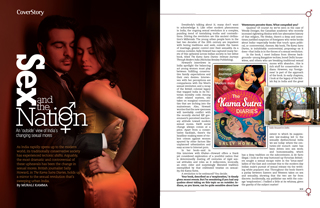
As India rapidly opens up to the modern world, its traditionally conservative society has experienced tectonic shifts. Arguably, the most dramatic and controversial of these upheavals has been the change in sexual mores. British journalist Sally Howard, in The Kama Sutra Diaries, holds up a mirror to the sexual revolution that’s sweeping urban India.
Everybody’s talking about it; many don’t want to acknowledge it. Like other modern phenomena in India, the ongoing sexual revolution is a complex, puzzling trend of tantalizing truths and contradictions. Driving the revolution are this ancient civilization’s Millenials. The young urban people born in the last two decades of the 20th century are impatient with boring traditions and seek, outside the haven of marriage, greater control over their sexuality. As a curious outsider, Sally Howard has captured many facets of this upheaval across Indian society in her debut book, titled The Kama Sutra Diaries: Intimate Journeys Through Modern India (Nicholas Brealey Publishing).
Howard’s interviews in India spotlight the balancing act young women must play between fulfilling conservative family expectations and their own desires. Interwoven with her perceptions are comparisons with the West’s sexual revolution and a recap of the British colonial legacy that trapped India in its Victorian morality code. Among other related matters, she takes on marginal communities that are inching into the mainstream. Also, Howard worries that the new openness will inevitably conflict with the recently elected BJP government’s perceived reactionary attitude toward modern sexual mores. Swift social change always comes at a price. Apart from a conservative backlash, there’s the headline–making wave of violent crimes against women spurred by other factors like unplanned urbanization and easy access to Internet porn.
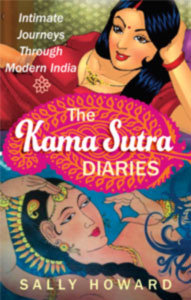
In her book—and in this interview with Khabar—Howard offers a frank yet considered exploration of a youthful nation that is determinedly dusting off centuries of rigid sexual attitudes and roles as it rediscovers, ironically, an even older and surprisingly liberated tradition exemplified by that celebrated treatise on sexuality, the Kama Sutra.
A revolution to be embraced? You decide.
Your book, described as a ‘sexploration,’ is timely
given recent events. But I’m wondering if you had any
qualms about taking on this topic as an outsider. Indians,
as you know, can be quite sensitive about how
Westerners perceive them. What compelled you?
Qualms? Of course! As we’ve seen in the case of
Wendy Doniger, the Canadian academic who recently
incensed rightwing Hindus with her alternative history
of that religion, The Hindus, there’s a deep and sometimes
justified suspicion of foreigners who write books
about India—especially books that touch upon political,
or controversial, themes. My book, The Kama Sutra
Diaries, is indubitably controversial, proposing—as it
does—that India is in the throes of a sexual revolution.
In the book, I meet Indians from diverse backgrounds— young Bangalore techies, bored Delhi housewives, and others who are breaking traditional sexual mores with abandon…this is rich stuff for conservative Indians. However, my ‘foreignness’ is part of the approach of the book. In early chapters, I look at the legacy of the British Raj in India and the great extent to which its suppressive law-making led to the sexually dysfunctional India we see today: where the centuries-old eunuch caste has been driven into sex work; and homosexuality, which has a deep tradition on the subcontinent, is de facto illegal. I look at the way buttoned-up Victorian Britishers sought a sexual escape valve in the ‘lotus-eyed’ ladies of the East and contrast this to the modern-day Indian male’s pursuit of sexual release via the writhing white pop/porn star. Throughout the book there’s a parlay between Eastern and Western takes on sex and sexuality, showing that the two are far from discrete. Incidentally, my publisher ran with the coinage ‘sexploration’; I balked a little at its whimsy, given the gravity of the subject matter!
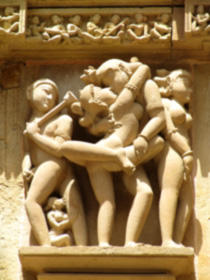
Khajuraho has become, in the last two decades, India’s second-most visited tourist attraction.
Your friend Dimple, who accompanied you on many of your trips, is fascinating. Does she epitomize the sexual revolution you witnessed in India? How do you see her?
Dimple was my companion pair of eyes on the trip, a journey which took us from the sweaty depths of Punjabi muscle gyms to the matriarchal communities of the Meghalaya mountains, from a Delhi rocked by the rape uprisings to the seat of the sensual dance tradition of Mohiniyattam in Kerala. Delhiite Dimple is a long-time friend, and a very new thing in India: a confident 32-year-old divorcée single mom. Throughout the book I weave in the responses of Dimple to the characters and themes
we encounter. Her reaction was endlessly fascinating to me as Dimple’s future, unlike mine, is invested in what India, after these painful spasms of change, will become. There’s something in Dimple—who escaped an unhappy arranged marriage against great odds—that gives me hope. Dimple, like many young Indians, is drawing strength from India’s ancient traditions: the depictions of flirtatious gods in Hindu myths, the erotic temple art, the world-famous Kama Sutra as postcards from an untroubled time and an Indian heritage that’s ripe to be rediscovered.
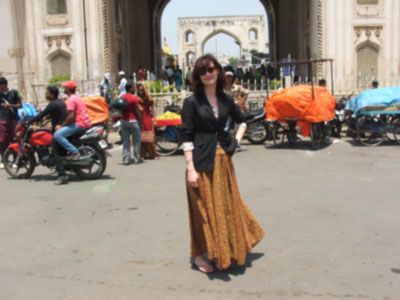
How was it in India when you first went there over 15 years ago? Was India’s sexual revolution, as you saw it, already underway—or is this a more recent phenomenon?
The greatest change has happened in the past ten years. Each year since 2003, newsweekly India Today has undertaken an annual Sex Survey. In 2003 fewer than 20 percent of young Indians who responded to the survey agreed to sex before marriage; in the 2013 survey that statistic nudged 50 percent. There are signs of this sea change everywhere
in India. As India’s Cosmopolitan [magazine] editor put it to me: “Indian conservatives expect us all to be virgins. But they’re living in a fantasy. Young Indian women are doing it; or want to do it. Not in S&M dungeons in New York like Samantha Jones in Sex and the City, not with fluffy handcuffs, usually in snatched moments in parked cars. But they are doing it.”
How does the sexual revolution in India differ from the one in the West? For instance, you talk about the rapid growth of love-cum-arranged marriages. Do they cut across the traditional lines of caste, language, even religion?
The Indian sexual revolution differs in that it’s not propelled, as the 1960s and 1970s Western sexual revolution was, by
second-wave feminism
and science (the latter
in the form of the invention
of, and ready access
to, the contraceptive pill).
It is similar to the Western
sexual revolution
in that it’s propelled by
a groundswell of young
Indians (as we know 60
percent of the Indian
population is under the
age of 25) who are rejecting
the social and sexual
mores of their parents.
Young Indians are flouting
the will of their parents
and making space
to be together. And, yes,
another factor in this revolution is technology.
Marital websites such as Shaadi.
com are empowering tech-savvy young
Indians to find their own mates. And yes,
formerly rigid caste preferences when it
comes to mating are beginning to shift,
especially in bigger metros.
India, as you noted, has a huge
youth population. Could you talk a little
more about the conflict between the
older and younger generations when
it comes to sexual relations? For instance,
you write about women being
GIG (Good Indian Girls) on the surface
and BIG (Bad Indian Girls) underneath.
Yes, there’s a fault line of communication
between the Indian Millennials,
the generation who have come of age
since the millennium, and their parents,
and grandparents. This younger generation
sees the world in a markedly different
way to their parents: they’re ambitious,
often Westernized, and have a
greater sense of individualism. This difference
of outlook manifests itself, naturally,
in conflict and secrecy. It’s young
Indian women who are at the frontline
in this battle, charged with upholding
strict social codes that are impossible in
the face of pressures from their peers,
and their own desire to be ‘modern’ girls.
So we have the modern phenomenon of
the young Indian woman leading a double
life—at home she’s the GIG, and with
her friends she’s the BIG.
As one of the young women managing this schizophrenic double life put it to me: “Good Indian Girls aren’t good. We only have to appear to be good to our elders, our family. As far as they want to know we’re working hard, thinking about finding a suitable husband. And we act that way: we keep everything sweet; we smile and serve chai to our grandpa. We know we have to preserve the nation by being virgins and having no fun. So we have our other lives, with our friends and our lovers.”
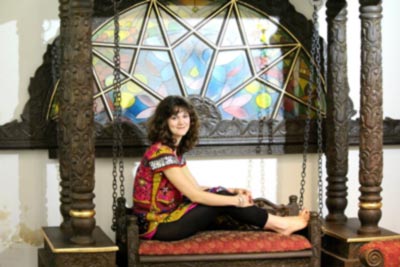
As a self-confessed
child of the Western sexual revolution,
you enjoy the kind of freedom that’s
usually not available to even Westernized
Indian women. Yet you seem a
little ambivalent. You write, “We were
told we could have it all; but somehow,
somewhere, we were had.” Would you
care to elaborate?
The sexual liberation proposed by
the Western sexual revolution was one
that emphasized women’s control over,
and enjoyment of, their own bodies.
This has not come to pass. In fact, in
many ways control of, and violence
inflicted upon, the female body is endemic
in our ‘pornified’ Western culture.
Sex has only truly been liberated in
terms of commerce: sex is everywhere
and is used to sell everything from soda
pop to pop songs. But we, as individuals,
are not liberated. The sexual revolution
in the West will be complete when
young women who enjoy sex without
marriage are not deemed ‘sluts’ while
their promiscuous male counterparts
are garlanded instead as ‘studs.’
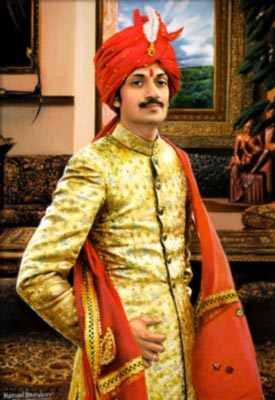
Manvendra Singh Gohil broke with tradition to become India’s first openly gay prince.
As a foreigner, was it hard to penetrate
Indian society and get people to
talk about their intimate lives?
Surprisingly, not. Indeed this ‘outsider’
take was one of the advantages of
being a foreigner. It doesn’t take much,
a couple of colas and a plate of street
food, to get Indian girls in a conspiratorial
mood; and many of the characters
I talked to, the Aghori Sadhus at Varanasi,
gay prince Manvendra Singh Gohil,
were sexual outsiders with nothing to lose in talking to me.
Could you comment on the recent re-criminalization of gay sex in India, which is a setback for the LGBT
community?
This is a sad thing as it exposes gay men, once again, to the brutality of
police corruption (police demanding bribes from gay men or, as frequently, sex). I think women have as much to worry about, however. There’s a perverse piece of myth-making amongst the
right that posits the demure and virginal bhartiya naari [ideal Indian woman] as the center of Indian society and the answer to the ‘Westernized’ liberal working woman. This is a dangerous rhetoric in terms of social progress.
Gender imbalance, the lack of opportunities, patriarchy, and the clash of cultures are given as some of the reasons for the rise in sexual violence. What’s also striking is the explosion of porn, easily available even to impressionable youngsters. Do you think it distorts the perception of women, both in India and the West?
It’s early days when it comes to
the grand experiment that’s underway, in India and the West, that entails
bombarding young minds with brutal stylized pornography via the Internet. Porn is ubiquitous in India. Indeed,
according to Google Trends, of the ten world cities with the greatest number of porn downloads in the world, seven are in India. What’s particularly troubling in India, what with the country’s much publicized epidemic of gang-
rape, is that ‘rape’ is the third most popular genre of porn in India. In many Western countries, too, rates of violent rape are increasing, especially those
involving gangs and young perpetrators and victims. I think this can be no coincidence. One key component of these
attacks is common to the December 2012 gang rape in Delhi and the Steubenville High School rape case in America: voyeurism, which appears to be a defining phenomenon of our age. Rather
than seeking help for a rape victim,
witnesses of these brutal acts recorded the events on their cellphones. This surely has to be a reflection of the
ubiquity of cellphone porn.
|
|
|
| The sex symbols Howard explores include macho bodybuilders (above) | and screen sirens like the late Silk Smitha (above). |
Dr. Reddy, the sexologist you spoke to, thinks Indian men have some catching up to do in the sexual revolution. Is it fair to say that Indian men are attracted to BIGs but want to marry GIGs?
Yes. Dr. Reddy, the busy sexologist I met in Chennai, echoed Rahul Roy, a documentary filmmaker, on the theme of masculine identity, in pointing out how far Indian men have to go to come to terms with the new Indian woman. The young Indian male perhaps enjoys his spunky female friends,
girls who have good jobs in tech companies, are standing on their own two
feet. Yet when it comes down to it, he wants to marry the safe, archetypical
Good Indian Girl. India’s newspaper
matrimonials reflect this fact, vaunting that tired cliché, the homely, traditional bride with her ‘wheatish skin.’
As Dr Reddy put it to me: “Naturally [the Indian man] likes to sexually fantasize over the idea [of a modern Indian girl],
but at the end of the day, he wants to
marry [someone like] his mother. The
Indian male is 10, maybe 15 years be-hind the Indian woman.”
What about sex education? Did you discover anything as you traveled around India, especially at schools
and colleges?
There is no mandated sex education
in India. Sex education is left to the discretion
of the school in question—which
means, in practice, that there is some
provision in progressive city
schools and none in their
rural counterparts. That
said, it’s a hot topic, with the
Indian health minister recently
arguing that sex education
in schools should be
banned and many health campaigners
and NGOs arguing, in riposte, for a
comprehensive sex education program.
I personally feel that ignorance is central
to the problem of India’s issues
around sex, as my audience with Dr.
Reddy in Chennai showed. Most of his
clients are young Indians who’ve entered
their marriages wholly ignorant of
the basics of sex and, as a consequence,
suffer both emotionally and socially.
|
|
|
| In India, according to Howard, “women’s bodies—Indian women’s bodies as well as those of Western women tourists—are a territory on which a societal war is being waged.” |
|
At one point Dimple says, “Whiteness
has become so synonymous with
beauty that even ‘dusky’ Bollywood
beauties like Priyanka Chopra endorse
skin-whitening creams.” Did you find
that globalization in India over the past
15 years has made this fixation on fairness
more pronounced?
I think the fairness fixation has
deep roots in India: the
elevation of Aryanism,
the colonial influence, the
centuries of fetishization
of the ‘white goddess.’
Today many modern Indians
feel that ‘whiteness’
in women is index linked
to ‘marriageability.’ What’s
new is the brutal commodification
of this transcultural
pathology. So we
have a 16 percent per annum rise in
sales of ‘whiteness creams’ in India; indeed
in 2013, sales of skin-lightening
creams in India totaled 258 tons. And
there’s a proliferation of new products in
the sector from—frankly—irresponsible,
multinational companies who are
capitalizing on the obsession,
from skin-whitening
products for children to
the risible ‘labia-bleaching
creams.’
The 2012 Delhi rape
case was notorious,
making headlines around
the world. But it was
also a game changer, as
you note, and one good
outcome was the Rape
Law. As you traveled
around India, did you find
any other signs of optimism
in this era of social and sexual
upheaval?
Yes, the 2013 criminalization of
stalking, voyeurism, and sexual harassment
sent out a strong message—
although it’s a tragedy that the law
fell short of criminalizing rape within
marriage. Huge changes are underway
in India and it’s inevitable—as in any
era of great change—that many Indians
will be caught under the wheels of this
cultural change of gear. But I found
much to be cheerful about: the number
of young male Indian feminists I met
(far outnumbering their Western counterparts);
the activists standing up
against the outrage of gang rape and
sexual violence; and, as I saw in Dimple,
young Indians rediscovering their rich
cultural heritage. There’s a long road
ahead, but there are exciting times to
come on the Indian subcontinent.
Enjoyed reading Khabar magazine? Subscribe to Khabar and get a full digital copy of this Indian-American community magazine.
blog comments powered by Disqus




